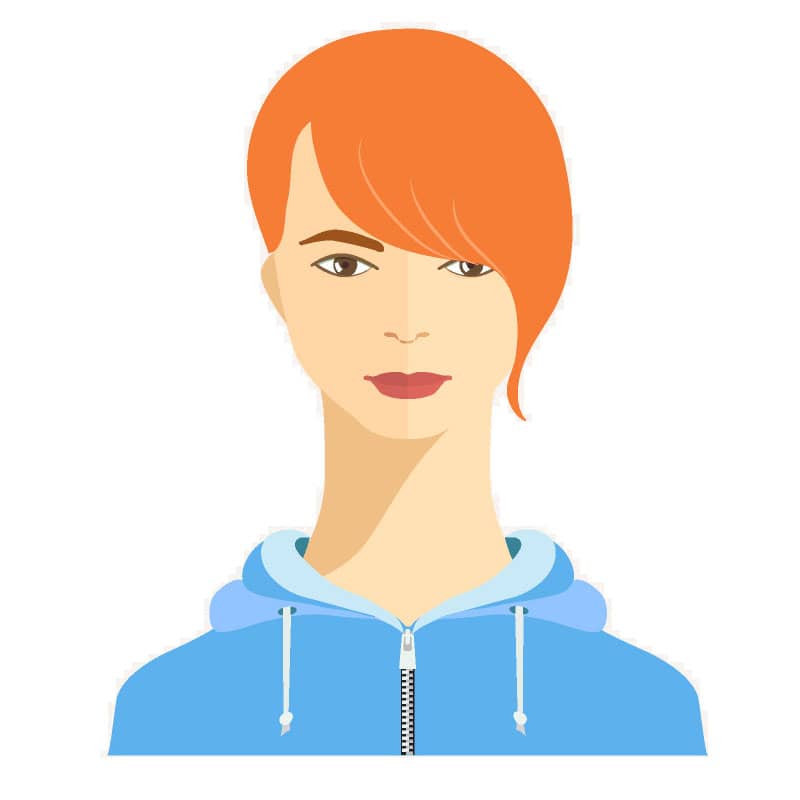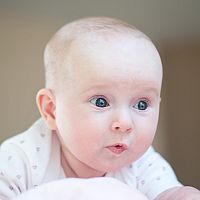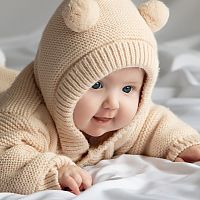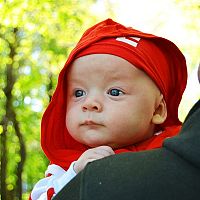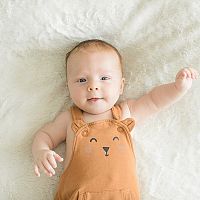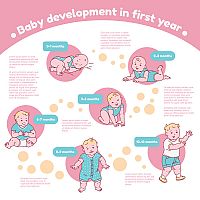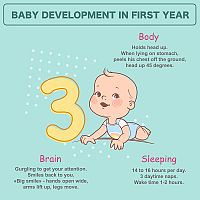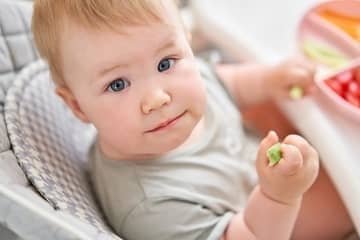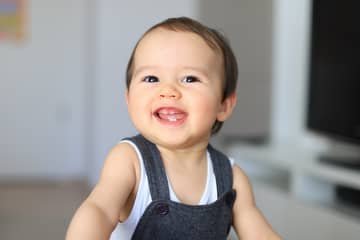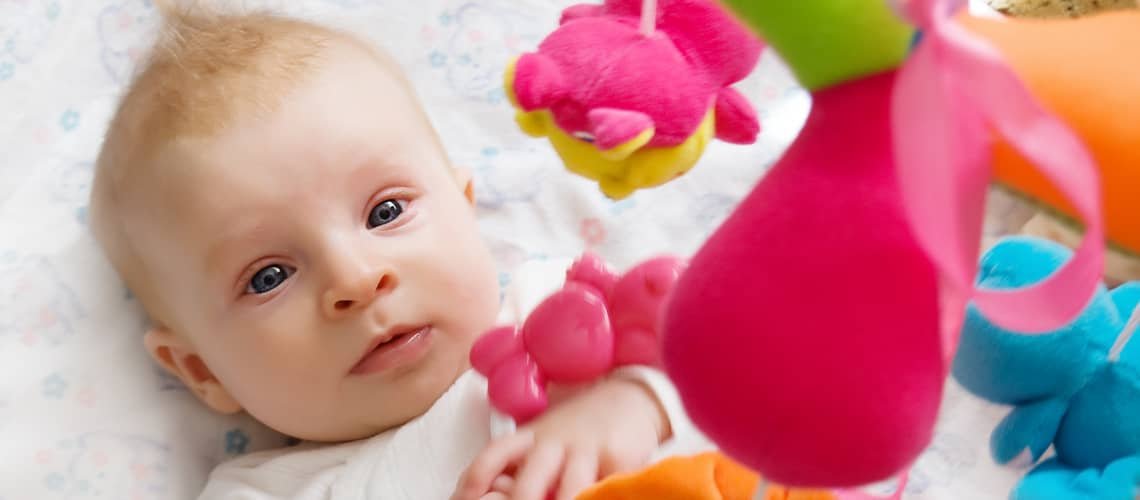
3-month-old baby (child) - development, diet, sleep, exercises, toys. See what it can do
Every pediatrician will confirm that the first weeks of a baby's life go by very quickly, and the parent sometimes doesn't even notice the small changes in the baby's appearance, movement or behavior week after week. At the same time, 3 months in a baby's life are often "breakthrough" in the sense that more visible differences can appear between peers. While the development has been relatively smooth until now, the 3-month-old baby is already beginning to show his will, interacts with the environment more intensively, stays awake longer and more significant changes also occur in the infant's psychomotor development. Sensory perception progresses and it forms its own attitudes towards the many stimuli it comes into contact with at this age.
A parent must realize an important thing. What a 3-month-old baby can do is not set in stone. It is still true that the development of each child is specific and each child has his own pace. Differences between peers may start to become more visible at 3 months, but comparison is definitely not the right way to categorize a child. Progress during this period is not a future factor for the child's later mental and physical development or intelligence level. If the pediatrician is satisfied and identified with the child's progress, the parent need not worry that their child is missing something. Does a 3-month-old baby really sleep a lot? What games are suitable for a 3-month-old baby?
What can a 3-month-old baby do?
Parents often determine a baby's development by what it can do in terms of movement, walking, sitting, talking, etc. In the first weeks and months, some changes in psychomotor development are more pronounced than others. Even the parent doesn't even notice many little things. The second thing is that it is not written anywhere that a specific characteristic of development must occur in every child in the 3rd month. Some advances overlap and come in parallel and quietly even later.
In the 3rd month, the typical bending of the limbs in the joints is lost. The limbs are already stretched and not bent so much at the elbow or knee. Movements become much smoother overall. It's not just dynamic jerks anymore. Movements tend to be deliberate. This also applies to head movements. Until now, when lying on the back, the baby turned its head to one side or the other, now the typical position is in the middle. The palms are already open and not clenched into fists. Although the grip is not yet functional, the effort to reach for objects is evident.
When lying on his back, the child visually discovers his hands. He can lift them and direct them towards the mouth. It is a conscious movement. Their licking and sucking is completely typical for this age. Salivation is also typical, because the salivary glands are activated. Holding each other's hands is also a common phenomenon in a 3-month-old baby. The child grabs each other's hands, and that is just a step away from the fact that the subsequent reaching for objects - toys will end in grabbing them, which, however, is not yet fully functional. If you put a toy directly in his hand, he can hold it for a short time. From the position on the back, some children can turn to their sides for stimuli. Some even try to roll over from their back to their tummy, which with help can be a significant step in their development.
The first "grazing of horses, lambs or sheep" begins in the prone position. This is a developmental phase during which the child begins to hold the body symmetrically and create support with outstretched arms (does not lean on the elbows), while the spine straightens and the head is lifted up. At the same time, he can turn his head sideways and react to stimuli. If you pull the baby by the hands from the position on the back into a sitting position, the baby will hold its head for a few seconds. However, the baby cannot yet handle sitting by itself and do not practice it at this age, it does not have sufficient stability in the spine.
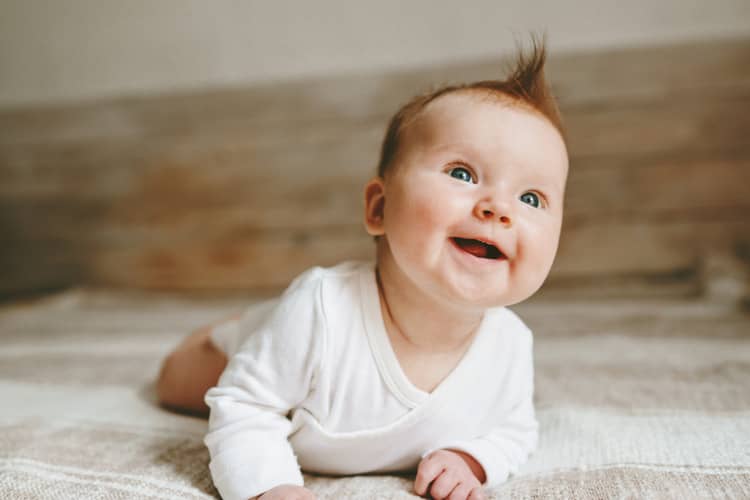
Communication and the world through the eyes of a baby at 3 months
As for sight, visual perception is a step better. The child still cannot see at a great distance, but the focus is improving. He can also follow dynamic objects and his eye movements begin to be coordinated. This is also evidenced by the coordination of the eyes and hands, which the child discovers with his sight, grabs them together and puts them in his mouth. Peripheral vision also gradually develops and the spectrum of colors expands. Thanks to his hearing, he reacts vividly to stimuli and turns to follow the sound source. He reacts to human speech, maintains eye contact, laughs and makes various grimaces. The spontaneous burst of laughter is also only a matter of time, and at that moment the parent gets the feeling that communication with the child is finally "present". By talking to the child, you support his speech skills.
The baby begins to try to communicate with different sounds - grr, eh, neh, ah, ou, and others. Loud muttering is typical. However, it is still too early to talk about something. Sensory perception works, a 3-month-old baby observes objects or human faces. He begins to recognize them based on features and not just outlines. He has no problem communicating with strangers by smiling and grimacing. In addition to the fact that the child discovers himself, he notices everything that happens around him. Not everything will interest him in the same way, but through active communication and various stimuli (toys and games) you will encourage him to be more active and thus develop his senses.
Doctor's examination and mandatory vaccination
Once again, it is important not to neglect the preventive examination of your baby. After all, the date of the next and the next check-up is always determined by the pediatrician himself. He will again assess the overall health of the infant, measure and weigh him. He also asks mothers about all important information regarding breastfeeding, bowel movement or sleep. The state of fusion of the cranial bones is also determined - the closure of this area is assessed by tactile examination of the fontanel (note the place where the cranial bones fuse). It is finally closed around the 18th of the month. This is also why, for better bone growth, the child is usually prescribed vitamin D and K support therapy at the first check-up in the 1st month.
Also, the 3-month-old baby is compulsorily vaccinated with the 1st dose of hexavaccine, which includes effective antibodies against diseases such as diphtheria, tetanus, jaundice type B, whooping cough, hemophilus and cerebral palsy. The vaccine is administered in the front part of the thigh. The child is also vaccinated with the 1st dose of the vaccine against pneumococcal invasive diseases. Subsequently, the 2nd dose of mandatory vaccination against the mentioned diseases is applied in the 5th month and the 3rd dose in the 10th to 11th month.
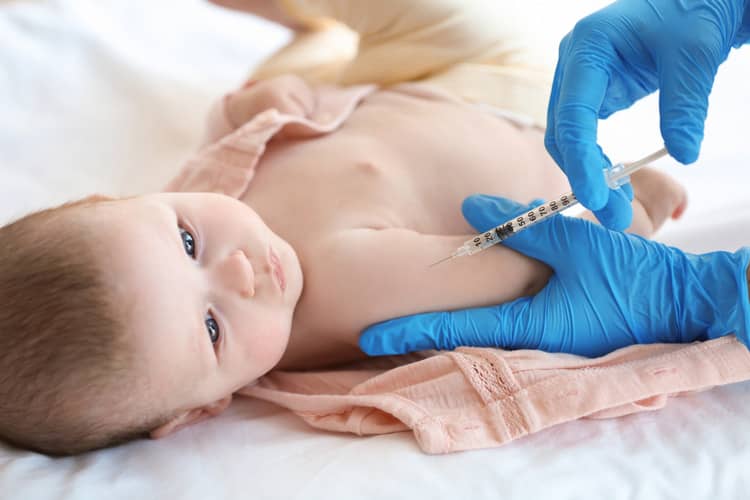
A 3-month-old baby does not want to suckle
The basis of the diet is still mother's milk, and there is no need to deal with additional feeding at the moment if the child is gaining weight and thriving. After all, the pediatrician himself will evaluate it during the check-up. In the 3rd to 4th month, the baby should gain 70 to 110 g per week (according to WHO). Possible infant colic, full of crying and sleepless nights, should gradually disappear. There is still a risk that a breastfeeding mother may develop a lactation crisis. Again, however, this is only a temporary state, which is typical for the 3rd to 5th month. It does not happen to every mother. It is not necessary to switch to artificial milk, it is important to support milk production by frequent feeding of the baby and other suitable methods.
Due to a weaker milk flow, the child may refuse to breastfeed or suckle only for a short time. It is important to continue breastfeeding. If a 3-month-old baby does not want to suckle, the reason may be a slight change in the taste of breast milk. It occurs after the end of the sixth week, but the change in taste can also be influenced by inappropriate food, which can affect the taste or smell of milk. It is still true that a woman should continue breastfeeding. He can ask for advice, for example, from a lactation consultant. Formula milk is the last option. An incorrect position or breastfeeding technique can also be at fault.
Sleep and toys for a 3-month-old baby
How is a baby's sleep at 3 months ? It is shortened again. The total sleep time within 24 hours is 10 to 12 hours. The waking hours are getting longer and there is definitely no boredom waiting for the parents. Due to the fact that the baby's biorhythm changes, it is important that the sleep periods during the day are not too long, otherwise sleeping at night will be problematic. Always stick to the rule that it is important to establish rituals before going to sleep, which will be a clear sign that the time for sleep is coming without delay. Ideally, nighttime sleep should be longer. Don't be afraid of co-sleeping either, be close to the child. At the same time, you will make night breastfeeding easier.

A nervous 3-month-old baby
Some mothers experience that the baby is restless and nervous between the 3rd and 4th month, despite the fact that its needs are met. The circadian rhythm matures in this period. This is the reason why the child begins to sleep less during the day or the sleep intervals are very short. As the child grows tired during the day, nervousness also increases. It is about the so-called sleep regression. Sleeping habits change. Many moms believe that a 3-month-old baby is teething, but this is rare. Restlessness can also be caused by other health problems, so pay attention to various symptoms.
Games and exercises for a 3-month-old baby
Conscious movements controlled by the will gradually begin to prevail in the child. So it is not just about reflexive movements, but about deliberate movement of the head or hands. Not to mention a conscious attempt to roll onto your side or stomach. Most babies can do this on their own between 4 and 7 months. It is important that you can stimulate the child to develop his psychomotor skills with various games and activities.
In addition to having toys such as rattles, play toys, merry-go-rounds or plush toys at hand, you can also stimulate the baby with other stimuli from the 3rd month. For example, caress the baby's feet, grab the fingers and talk to him. Try the classic nursery rhyme "The mouse cooked porridge". Approach the baby's eyes with your face in close proximity, stick out your tongue, make grimaces and watch the baby's reactions. Making monkeys is a fun program for every child.
Stimulate the baby's senses with moving toys. Ideally, they should be as colorful as possible. You can also exercise with your child on a mat. Place the child naked on the mat and support the movements of his arms and legs. Put rattles in his hands, develop his grip. Stroke it all over your body. Change the positions from which you speak to him.
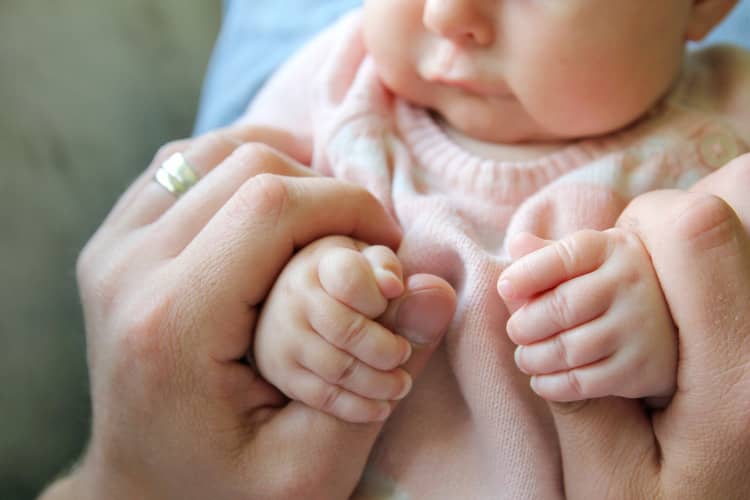
The most frequent questions - FAQ
Do you consider 3 months in a baby's age to be a turning point? Do you notice that the baby is starting to behave differently? It's okay, the baby starts to perceive his will and consciously starts to coordinate his movements. He reacts to stimuli to which he forms his own first attitudes - negative or positive. What is your experience with the development of a 3-month-old baby? Have certain shortcomings appeared in your case? Did your baby's development surprise you in any way? We will be happy if you share your personal experience with other mothers. Join the discussion under the article, you can help other readers.
Why does a 3-month-old baby drool? Does drooling mean that a 3-month-old baby is teething?
How to carry a 3-month-old baby?
Is a 3-month-old baby already lying on his stomach?
Gallery
Pridať komentár
